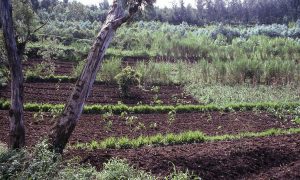 Agroforestry—the use of trees in farming—benefits both farmers and the environment.
Agroforestry—the use of trees in farming—benefits both farmers and the environment.
According to a recent report by Biodiversity International, the Center for International Forestry Research, the World Agroforestry Centre, and Charles Sturt University, forests contribute to the livelihoods of more than 1.6 billion people. Yet, 30 percent of the world’s forests are used primarily for the production of wood products.
Agroforestry is defined as the integration of trees and shrubs into crop and animal farming systems. These practices can help landowners diversify products and create social, economic, and environmental benefits.
Trees and forests provide more than just food—they can enhance soils, protect biodiversity, preserve precious water supplies, and even help reduce the impacts of climate change.
According to the World Agroforestry Centre, agroforestry is uniquely suited to address the need to grow more food and biomass for fuel while sustainably managing agricultural landscapes for the critical ecosystem services they provide.
Agroforestry efforts in Niger, for example, have resulted in 200 million trees being planted on over 5 million hectares of farmland. This has impacted an estimated 2.5 million people by improving soil, increasing yields, and creating resilience against climate change.
This week, Food Tank is highlighting 16 organizations and projects that are using agroforestry principles to bring benefits to farmers, communities, and the environment.




